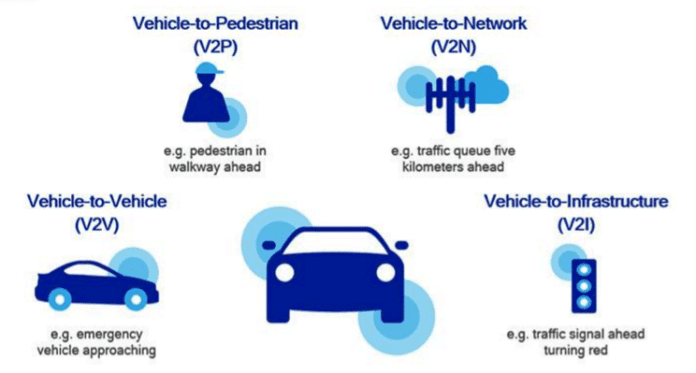C-V2X links vehicles to pedestrians, infrastructure, the network and other vehicles
As trials pick up and automakers partner with telecom ecosystem stakeholders to advance vehicle connectivity on the way to autonomous driving, let’s take a look at the wireless connectivity linking vehicles to the world around them, and answer the question, “What is C-V2X?”
C-V2X communicates to a cellular network for cloud-based services like navigation and infotainment; it uses a direct link to communicate with other vehicles, smart infrastructure and pedestrians. C-V2X is based on 3GPP’s Release 14 and builds on the IEEE’s 802.11p standard for dedicated short-range communications (DSRC). C-V2X uses 5.9 GHz ITS spectrum.
According to an IEEE blog, “C-V2X is expected to be instrumental in transforming connected transportation services throughout the globe. C-V2X direct communications can operate both in ITS spectrum and in commercial cellular spectrum, combined with network-based C-V2X communications operating on existing and future cellular networks. The newly formed 5GAA is a clear proof of the existence of a strong ecosystem of leading automotive and telecommunication companies which is confident that a technically superior standards-based, cost-effective and scalable access technology from the cellular industry will carry C-ITS and Connected Vehicle applications well into the 5G era and beyond.”
Qualcomm, a major player in DSRC and C-V2X, announced the first-ever U.S. deployment in partnership with Ford and Panasonic. “Recent field test results show a significant range, reliability, and performance advantage of C-V2X direct communications, with more than twice the range and improved reliability compared to 802.11p radio technology,” according to Qualcomm.
The trials will take place in Colorado, which has developed a plan called RoadX, with the goal of becoming crash-free through technology. The state’s Department of Transportation and partners will add C-V2X devices to a fleet of Ford vehicles. Click here to learn more.
Earlier this year Ericsson, Qualcomm, together with Japanese telco NTT Docomo and other firms including Nissan and Continental, announced plans to carry out their first cellular vehicle-to-everything (C-V2X) trials in Japan. The partners said that the trials are designed to show the enhanced range, reliability and latency benefits of C-V2X direct communications operated in 5 GHz band. Additionally, the C-V2X Trials are designed to demonstrate the complementary benefits of network-based communications utilizing LTE-Advanced (LTE-A).
In Germany, Huawei, Vodafone Germany and Bosch tested the extended usage of cellular C-V2X technology in combination with Bosch’s adaptive cruise control (ACC) driver assistance system. In March the partners said they have been performing trials of the new technology for the last 12 months on the A9 freeway in Bavaria, Germany, using a pre-standard 5G network. The involved firms also highlighted that the real-time integration of C-V2X with ACC driver assistance system will deliver more efficient and safer driving.
“The new mobile technology system paves the way for automated driving. Achieving the goal of fully connected traffic will involve teaching vehicles to communicate with each other and exchange data directly,” Huawei said in a statement. “Direct communication between vehicles provides information about what is happening in parts of an intersection not visible to the driver, over the crest of a hill, or on the freeway beside or behind the driver’s own car. In addition, the technology will increase energy efficiency and reduce emissions. Overall, traffic becomes smoother and more efficient.”

